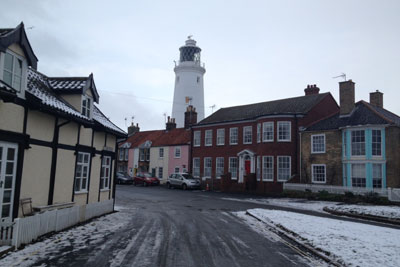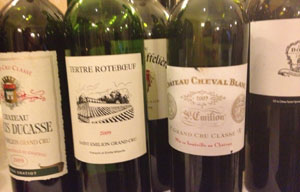First up at Southwold 2013 were the 2009 Saint Emilions. And what a lot of them there were! We tasted about 75 wines from this village as well as a few “ringers” from neighbouring appellations. The way that we organise these tastings is to serve the wines blind in flights with 10-12 bottles per flight. They are served, within each flight, in random order, alongside wines of similar value, style and reputation. As my son Ben was not due back at University until the following week, he helped out with the opening, “bagging” and serving of each flight. Ben’s other job was to enter everyone’s score on a spreadsheet. After 20 minutes silent tasting, each participant gives a score out of 20 for each wine (before the wines are discussed or their identities revealed) and then a group average score is calculated. Healthy debate then follows….

Snowy Southwold in January 2013
|
Saint Emilion, as I have written before, is always the most diverse and disparate appellation that we taste. Pauillac tastes like Pauillac. Pomerol tends to taste like Pomerol. There are weaker Pomerols (on the sandier terroirs near Libourne), good ones (up the slope a little) and great ones (on the plateau near to Pétrus) but they are all, more or less, versions of the same thing. Saint Emilion is all over the place!
First of all there is a huge difference in terroirs. The vineyards to the West are really on the same soil as Pomerol. In fact Cheval Blanc’s vineyard is partly over the border and its terroir is pretty much identical to that of La Conseillante. Vineyards such as Monbousquet are on flat, sandy soils down by the river Dordogne while others such as Faugères are several miles to the west towards Castillon. Most of the top names, however, are situated on the best, steep south-facing slopes around the medieval village of Saint Emilion itself with Ausone, Belair-Monange and Pavie reputed to be in the prime positions.
Then there are the grapes. Whilst Pomerol is pretty much all Merlot, in Saint Emilion there are varying percentages of Cabernet Franc in the blends. Peby Faugères, for example, is 100% Merlot but at Angélus Merlot is in the minority. At Figeac the mix is one third each Cabernet Sauvignon, Cabernet Franc and Merlot.
Finally, and most important of all is the input of people. The wine-making techniques used by the various properties vary enormously. Some pick their grapes a whole month later than others. Some use 100% new oak, some use none. Some use all sorts of modern techniques and some are very traditional. All of these differences ensure that a blind wine-tasting of Saint Emilion is like tasting wines from all parts of the world rather than a small village in France.

2009 Saint Emilions
|
A few wines scored badly in these flights and these tended to be wines made in a rather “extracted” style. 2009 is naturally a wonderfully ripe, plump, sexy vintage and our group seemed to be particularly un-impressed by Chateaux where the wine-maker had decided to “pump up the jam” too much. You really don’t need to turn up the volume to 11 when you can already hear the music quite clearly. The worst offenders here, I’m afraid, were Faugères, Laforge, Vieux Ch Mazerat, La Couspaude, Magrez-Fombrauge, Pavie Decesse and Le Dome. These are wines that are, perhaps, more to the taste of our American friends than the British palate.
With nature providing the vignerons with such perfect fruit in 2009, there were many wines that are sold at modest prices that out-performed expectations. Hats off to Aiguilhe (from Castillon), Virginie de Valandraud, Roc de Cambes (from Bourg), Cote de Baleau, Barde Haut and Fonplegade.
The real stars of the appellation really didn’t let us down and there were magnificent performances from the two “big guns” - Ausone and Cheval Blanc. The big surprise, maybe, was that the overall winner of all the Saint Emilion flights was the gorgeous Chateau Canon. This is a wine that really exudes class and it united both those who love old-school and modern wine-making styles. The top 5 scoring wines of the tasting from St Emilion were:
My own 10 favourite Saint Emilions, with brief notes and my scores, were as follows:
Canon La Gaffeliere – medium/deep, really charming on the nose. This actually tastes like St Emilion! Silky, smooth and supple. A seductive charmer. 17 points
Pavie – deep colour. A huge smoky, spicy nose. Licorice and a touch of aniseed. Sexy stuff. Enormous but the fruit and tannin are in balance. Very modern style but has classic structure. Heavyweight. 17 points
Troplong Mondot – This is very decadent and opulent. Low acidity, concentrated black fruit, oodles of cream. Plummy and rich. Super-ripe and super-sexy. A blockbuster. Hard not to be impressed. 17 points
Angelus – A very deep colour. This is serious! Chewy, dense and extracted. A touch of exotic coconut and Asian spices. There are masses of fruit here and some quality wine-making. A long-distance classic. Needs 10 years at least. 17 points

A flight "bagged-up" and ready to be poured
|
Tertre Roteboeuf – This wine has an absolutely massive soaring nose. Big alcohol. Intense, super-sexy and sweet. Like a concoction of Asian spices. Incredibly decadent. Almost over-powering. So opulent and seductive. 17.5 points.
Pavie Macquin – A deep colour, hot nose. Huge, intense and full of fruit. Prune-like intensity. This is very big, almost at the limit, but is not too forced. Lots of spice here. 18 points.
Valandraud – A very deep colour. This seductive wine has a super-sweet nose. Sensational richness and cream on the palate. Very round, very polished with some high class vanilla oak. A gorgeous wine. 18 points
Canon - Cool and fresh for the vintage, yet clearly ripe and rich. Very finely balanced, Classy. Really fine and the essence of genuine St Emilion. An intensely serious wine. Superb. Winner of the flight from the group. 18.5 points.
Cheval Blanc – A sumptuous, seamless wine with oodles of cream. Plump and succulent. Very seductive but incredibly pure and classy. This is more Pomerol than Saint Emilion and it is absolutely gorgeous. 19 points.
Ausone - A black colour and a powerful, serious nose. This is incredibly intense yet has brilliant balance and structure, Linear. Supreme class and quality. Neither old school nor modern. Truly great, classic Bordeaux and needs time. 19.5 points.